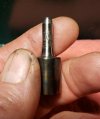the casting for higher velocity thing wears me out, I can't just go on a 4 hour cruise like I do with my lyman 4 cavity pistol molds and know I now have 1-2000 'good nuff' bullets.
it's like maybe 20 minutes or so setup time, then a good hour or maybe 1.5hrs. of concentration of how I'm pouring, mold placement, counting, watching what comes out, and sprue management [how big, where the alloy hits it, color] and then feeling the break [and looking at the base] to determine how much faster or slower I need to be going at any given time.
I've thrown back entire batches of bullets more than once if I'm not getting what I want, and waiting until I have another day to go at it again.
what's even harder is when I purposely want a slight rounding on the gas check base, and have to fiddle with pouring a small sprue button just big enough to suck in alloy, but not large enough to fill out the bottom edges, then pour over the top of them to keep the plate warm and make sure I can get the sprue out of the plate.


www.rcbs.com

